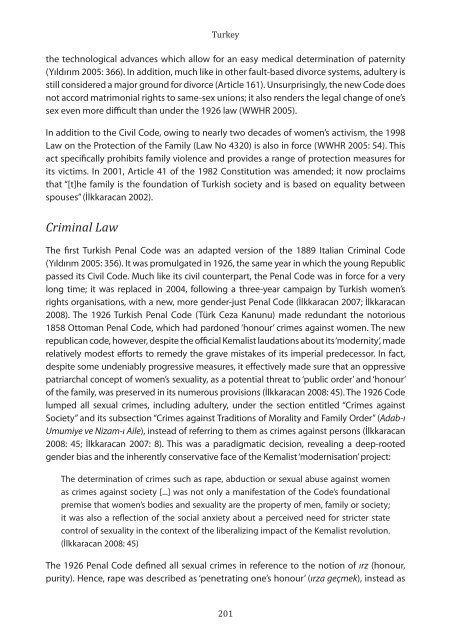control and sexuality
control and sexuality
control and sexuality
- No tags were found...
You also want an ePaper? Increase the reach of your titles
YUMPU automatically turns print PDFs into web optimized ePapers that Google loves.
Turkeythe technological advances which allow for an easy medical determination of paternity(Yıldırım 2005: 366). In addition, much like in other fault-based divorce systems, adultery isstill considered a major ground for divorce (Article 161). Unsurprisingly, the new Code doesnot accord matrimonial rights to same-sex unions; it also renders the legal change of one’ssex even more difficult than under the 1926 law (WWHR 2005).In addition to the Civil Code, owing to nearly two decades of women’s activism, the 1998Law on the Protection of the Family (Law No 4320) is also in force (WWHR 2005: 54). Thisact specifically prohibits family violence <strong>and</strong> provides a range of protection measures forits victims. In 2001, Article 41 of the 1982 Constitution was amended; it now proclaimsthat “[t]he family is the foundation of Turkish society <strong>and</strong> is based on equality betweenspouses” (İlkkaracan 2002).Criminal LawThe first Turkish Penal Code was an adapted version of the 1889 Italian Criminal Code(Yıldırım 2005: 356). It was promulgated in 1926, the same year in which the young Republicpassed its Civil Code. Much like its civil counterpart, the Penal Code was in force for a verylong time; it was replaced in 2004, following a three-year campaign by Turkish women’srights organisations, with a new, more gender-just Penal Code (İlkkaracan 2007; İlkkaracan2008). The 1926 Turkish Penal Code (Türk Ceza Kanunu) made redundant the notorious1858 Ottoman Penal Code, which had pardoned ‘honour’ crimes against women. The newrepublican code, however, despite the official Kemalist laudations about its ‘modernity’, maderelatively modest efforts to remedy the grave mistakes of its imperial predecessor. In fact,despite some undeniably progressive measures, it effectively made sure that an oppressivepatriarchal concept of women’s <strong>sexuality</strong>, as a potential threat to ‘public order’ <strong>and</strong> ‘honour’of the family, was preserved in its numerous provisions (İlkkaracan 2008: 45). The 1926 Codelumped all sexual crimes, including adultery, under the section entitled “Crimes againstSociety” <strong>and</strong> its subsection “Crimes against Traditions of Morality <strong>and</strong> Family Order” (Adab-ıUmumiye ve Nizam-ı Aile), instead of referring to them as crimes against persons (İlkkaracan2008: 45; İlkkaracan 2007: 8). This was a paradigmatic decision, revealing a deep-rootedgender bias <strong>and</strong> the inherently conservative face of the Kemalist ‘modernisation’ project:The determination of crimes such as rape, abduction or sexual abuse against womenas crimes against society [...] was not only a manifestation of the Code’s foundationalpremise that women’s bodies <strong>and</strong> <strong>sexuality</strong> are the property of men, family or society;it was also a reflection of the social anxiety about a perceived need for stricter state<strong>control</strong> of <strong>sexuality</strong> in the context of the liberalizing impact of the Kemalist revolution.(İlkkaracan 2008: 45)The 1926 Penal Code defined all sexual crimes in reference to the notion of ırz (honour,purity). Hence, rape was described as ‘penetrating one’s honour’ (ırza geçmek), instead as201


